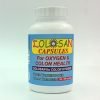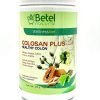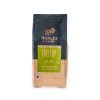Courtesy of Phoenix Tears
The Rick Simpson Process of Producing Hemp Oil
“I usually work with a pound or more of bud from very potent high quality indica or indica dominant sativa crosses. An ounce of good bud will usually produce 3 to 4 grams of high-grade oil and the amount of oil produced will vary from strain to strain. You are never really sure how much oil you will get until you have processed the material you are working with. On average, a pound of good bud will usually produce about 60 grams of high-grade oil and sometimes you may even get substantially more from some varieties.
Many seem to believe the oil must be amber and that you should be able to see through it. Often the oils I produced did exhibit these traits but not always. The color and texture of the oil you are producing depends a great deal on the strain, method, and solvent that you are using to produce the oil. Don’t be concerned if the oil you produce happens to be darker in color, this does not mean that such an oil is not a potent medicine. Indeed some of the strongest oils I have ever produced were dark in color, but they still had the desired medicinal effects.
I think these instructions should make producing this oil quite easy for anyone, but before you start, make sure that you have everything you will need to do it properly. All one requires is the starting material, solvent, a length of wood, two plastic buckets, a few small containers with funnels and coffee filters, an electric rice cooker, a fan, a stainless steel measuring cup, a coffee warmer and syringes.
The process I am about to describe involves washing the starting material twice with a good solvent such as pure light aliphatic naphtha or 99% isopropyl alcohol to remove the available resin from the plant material. Light naphtha has proven itself to be a very good solvent to produce the oil, it is also quite cheap to purchase when compared to the cost of other solvents. It comes in different forms and under different names but the solvent I used is called light naphtha in Canada, and in Europe it is often called benzin(e). It is sold under many names but if you go to a fuel supplier, you should not have too much trouble tracking some down if you ask for hydrotreated light aliphatic solvent naphtha/petroleum ether/benzine/hydrocarbon solvent with a boiling point anywhere from 40 to 100°C (140 – 212°F), CAS number 64742-49-0.
Light naphtha has many industrial uses, and is often used to degrease engine parts or thin paints etc., so I’m sure you should have little trouble finding what you need. Just to give you an idea of its many uses, it is the same substance used to fuel Coleman lamps and stoves. But, unfortunately, rust inhibitors are added to Coleman fuel, so I do not recommend that this fuel be used to produce oil. There is also medical-grade naphtha (hexane) available in many countries in the world, but it is a bit more expensive and usually harder to get and I have not found any significant difference between pure light naphtha and the medical-grade version of it.
Butane can produce oil but I do not recommend its use as a solvent to produce this medication, since it is very volatile and would require the use of expensive equipment to neutralize the danger. In addition, using butane to produce the oil does not decarboxylate the finished product, so oils produced in this manner would be less effective for medicinal use, unless the extra time is taken to decarboxylate them properly.
The only solvents that I have direct experience with so far are ether, light aliphatic naphtha, and 99% isopropyl alcohol. Ether is my personal favorite and it is a very effective solvent but it is expensive and can be quite hard to get. I think the use of ether is better suited for closed distilling devices, since it is very volatile and its fumes make it dangerous to work with.
Both ether and light naphtha are more selective solvents in nature, which means alcohol is not quite as effective as a solvent but still it does work well. Alcohol will dissolve more chlorophyll from the starting material and due to this, oils produced with alcohol will usually be more noticeably dark in color.
For a solvent to be effective, it should be 100% pure and 100% pure alcohol is expensive and can be quite hard to find. Light naphtha on the other hand is quite cheap to acquire and is usually not too hard to locate. Next to the use of ether, pure light aliphatic naphtha is my solvent of choice.
All these solvents including alcohol are poisonous in nature but if you follow these instructions, solvent residue in the finished oil is not a concern. After the finished product cools to room temperature, it is a thick grease-like substance rather than an oil and it is about as anti-poisonous as you can get. Even if there was a slight trace of solvent residue remaining, the oil itself would act upon it to neutralize any harmful poisonous effect. In essence, all you are doing is washing the medicinal resins off the bud material. Then, after the solvent oil mix has been filtered and the solvent has been boiled off, you are left with the resins in their most medicinal form.
For best results, the starting material must be as dry as possible. Be sure where you are working is well ventilated and there are no sparks, open flames, or red-hot elements in the area.
Place the starting material in a container of good depth to prevent the oil solvent mix from splashing out during the washing process. Then, dampen the bud with the solvent being used and the bud material is then crushed using a length of wood such as a piece of 2×2.
After it has been crushed, add more solvent until the material is completely immersed in the solvent. Work the bud material for about three minutes with the length of wood you used to crush it. Then slowly pour the solvent oil mix off into another clean container, leaving the starting material in the original container, so it can be washed for the second time.
Again add fresh solvent to the starting material until it is once more immersed in the solvent, and then work it for three more minutes with the length of wood you have been using. Then, pour the solvent oil mix into the same container that is holding the solvent oil mix from the first wash you did.
Trying to do a third wash on the plant material produces very little oil and it would be of little or no benefit as a medicine. The first wash dissolves 70 to 80% of the available resin off the starting material; the second wash then removes whatever resin that is of benefit, which remains.
Oils produced from the first wash are the most potent medicinally but if high-grade starting material is used, oil from the second wash also has benefits. If, for some reason, you have to work with material that is not as potent as it should be, it is best to use the oil from the first wash only for internal use and then start to grow or look for starting material that is of better quality. Remember, quality is more important than quantity and the better the starting material, the better the medicine.
Use something such as clean water containers with a small opening at the top and insert funnels into the openings, then put large coffee filters in the funnels. Pour the solvent oil mix from the first and second washes into the coffee filters and allow the solvent oil mix to drain through the filters to remove any unwanted plant material. The more funnels and containers you use, the faster it will be filtered. Once the solvent oil mix has been filtered, it is now ready to have the solvent boiled off.
If you do not already own one, you can purchase an inexpensive larger rice cooker with an open top that has both high and low heat settings to boil the solvent off the oil. Make sure that the rice cooker is set up in a well-ventilated area and place a fan nearby to blow away the fumes as the solvent boils off. This will prevent the fumes from condensing and posing a danger. Rice cookers are designed not to burn the rice as it cooks. The temperature sensors that are built in will automatically switch the cooker back on the low heat setting if the temperature within the cooker begins to get too high.
When producing oil, if the temperature gets a little over 300°F (148°C), it will begin to vaporize the cannabinoids off the oil and, of course, you do not want this to occur. If a rice cooker is working properly, it will automatically come off the high heat setting at roughly 230°F (110°C), which is above the temperature where decarboxylation is said to occur and is still well below the point that THC and other cannabinoids will vaporize. This is why I strongly recommend the use of a rice cooker to those who have never produced oil before, since it eliminates any danger of harming the oil in question. Plus the resulting oil is decarboxylated, which is also important, so it can achieve its full medicinal effects.
I suggest that people should not try to use crock-pots and similar appliances to produce oil. When I first tried to produce the oil, I used a crock-pot and since I did not know how much heat these devices can generate, the oil overheated and was ruined. So I think it’s only sensible that a beginner should start out by using a rice cooker and follow our instructions carefully. Doing so could save them a lot of grief.
A distilling device can also be used to produce this medication and reclaim the solvent that is being used. This method really does make more sense than using a rice cooker, but stills that are designed to boil off solvents safely are expensive and most people do not know how to operate one of these devices properly. If one is available, I prefer to use a still myself, but, in some countries, owning a still is against the law. If one is serious and wants to produce large amounts of oil, look into distilling and educate yourself in the proper use of this equipment.
Always make sure there are no sparks, open flames, or red-hot elements in the area while you are filling the rice cooker or boiling the solvent off because the fumes produced from solvents are very flammable and toxic. I have used this same process thousands of times and have never had a mishap, but for your own safety, please follow the instructions and make sure the area is well ventilated. I also caution you to avoid breathing in the fumes that solvents produce since they can have unpleasant effects on anyone nearby.
Make sure that the fan is running and produces enough airflow to blow away the fumes, then fill the rice cooker until it is about three quarters full. This allows room for the solvent oil mix to boil off without spilling over. Put the rice cooker on its high heat setting and begin boiling the solvent off. Never attempt to do this without the use of a fan, since the fumes could condense and if they come in contact with the heating element, it might cause a fire.
As the level in the rice cooker drops, continue to carefully add the solvent oil mix you have remaining, until you have nothing left. When the level in the rice cooker comes down for the last time and has been reduced to about two inches of solvent oil mix remaining, add about 10 to 12 drops of water to the solvent oil mix that remains. This small amount of water allows the remaining solvent to boil off the oil that remains in the cooker more readily.
When there is very little remaining in the cooker, I usually put on a pair of gloves and then pick up the cooker and begin swirling its contents. This is done with the airflow from the fan still taking the fumes away and it can speed up the finishing process slightly. In a short time, the cooker automatically kicks off its high heat setting and then goes to low heat. As the last of the solvent is being boiled off, you will hear a crackling sound from the oil that is left in the cooker and you will see quite a bit of bubbling taking place in the oil that remains. Also, you will notice what looks like a small amount of smoke or steam coming off the oil in the rice cooker, but don’t be concerned, as this is mostly just steam produced from the few drops of water that you added. After the rice cooker has automatically switched to its low heat setting, I usually let it cool until it can be switched to the high heat setting again. After the cooker has automatically switched itself to the low heat setting for the second time, I then take the inner pot out of the cooker and pour its contents into a stainless steel measuring cup.
There will be a small amount of oil remaining in the pot that you will find almost impossible to get out, unless you use something like dry bread to absorb the oil, while it is still warm. Then, small amounts of this bread can be eaten as a medicine, but remember it can sometimes take an hour or more before you feel its effects. So be careful how much bread like this you consume, because even a very small amount may put you to sleep for quite a few hours just the same as the raw oil will do itself. Another good way to clean up whatever oil remains in the pot is to wash the pot out with a small amount of alcohol to produce a hemp oil tincture.
A tincture such as this can be very effective in the treatment of skin conditions and just a little can go a long way, which can save you money. Since I often like to mix oil from several strains anyway, I usually simply leave the remaining oil in the pot until next time. By mixing oils from different strains, you receive the medicinal benefits from all these different types of oil and I have found such oils to be effective in the treatment of everything. If you have many different varieties of good hemp at your disposal, I think mixing the oils is a good idea, but if you do not, I believe the oil from just one strain will probably satisfy your needs.
Take the oil that you poured into the stainless steel measuring cup and put it on a gentle heating device such as a coffee warmer to evaporate off whatever water remains in the oil. Quite often, it only takes a short time to evaporate the remaining water off, but also some strains produce more natural terpenes than others. These terpenes can cause the oil you now have on the coffee warmer to bubble for quite some time and it may take a while for such oils to cease this activity. When the oil on the coffee warmer has stopped bubbling and there is little or no activity visible, take the oil off the coffee warmer and allow it to cool a bit.
Another way to finish the oil without the use of a coffee warmer is to put the oil in an oven set at 130°C (266°F) for about an hour. Both of these methods will decarboxylate the finished oil and solvent residue should not be an issue.
Then, using plastic applicators or syringes with no needles that are available in your local drug store, use the plunger to slowly draw the warm oil up into the syringes and allow it to cool. In a short time, the resin will become a thick grease-like substance.
Sometimes the resin is so thick that it can be hard to force it out of the syringes when cooled. If such a thing happens, simply put the syringe in a cup of hot water in a short time you will be able to squeeze your dosage out more easily. Sometimes a patient will force out too much oil, but if this happens, just pull back on the plunger of the syringe and the excess oil can usually be drawn back into the syringe without too much difficulty.
On average, a dry pound of material will require about 2 gallons (8-9 liters) of solvent to do the two washes that are required. If you plan to produce the oil from more or less starting material, simply do the math to determine roughly how much solvent you will require. From start to finish, it usually takes three to four hours to accomplish the whole process, and then the medicine is sitting there ready to be used.
It should also be mentioned that this oil has an extremely long shelf life. But for long-term storage, I would put it in a dark bottle with a tight lid or a stainless steel container. If kept in a cool dark place when stored, it can maintain its medicinal potency for years.
At first, it may seem daunting for some to try to produce their own medicine but in reality, this process is extremely simple. All you have to do is carefully follow the instructions and after you produce this medication a couple of times, you will find that it is not much harder to make than a cup of coffee. Once you have produced your own medication, it takes all the mystery out of medicine and you no longer have to rely on doctors in most cases, for now you have become your own doctor.” Rick Simpson
MAKING THE HIGHEST GRADE OIL
In the interest of allowing the common man to produce the highest quality and most medicinal oils possible, I have discovered a simple method that will enable just about everyone to produce oils with even more effective medicinal values than I have showed the public in the past. All you actually have to do is add a few more steps to the process we have already showed you, but after you produce oil in this manner I think you will agree that it does make a tremendous difference.
If you have high quality medicinal bud to work with, you should be able to manufacture oils with very high cannabinoid levels, simply by using a good solvent and a rice cooker. Oils that I produced in this manner usually showed THC levels of 95% or more along with varying levels of other cannabinoids and plant waxes. The healing power of oils such as this are what has finally given the cannabis hemp plant the medical recognition it deserves, but still I have found that the healing power of this substance can be taken to a whole new level without much difficulty.
All you have to do is take the oil and put it in a heating unit that can catch the cannabinoids as they vaporize off and this will produce oils of higher quality and purity. Although an ordinary vaporizer can accomplish this task, in truth they are not designed properly to fulfill this role, since it would take so long to produce any amount of medication and most vaporizers which are available tend to leak.
To produce oil on a larger scale one would require a much larger vaporizing unit which was airtight and it would also necessitate the use of a much larger collection dome that is set on an angle, so that once the cannabinoids started to collect they would begin to run down to the dome’s lowest point, where they could be collected from a small drain hole in the form of a highly purified oil. Anyone who is mechanically inclined should not have too much trouble putting together a unit to perform this task, but it will take a little time and effort to assemble the device.
The amount of oil which can be collected after it has been vaporized depends on what cannabinoid percentage by weight that the original starting oil had. If the oil you are using had 99% cannabinoids by weight, then you should get roughly that amount back after it has been vaporized.
I should also mention that this is a great way to improve the quality of lower grade oils which have a lot of impurities, so they may be used as a more powerful and effective medication. Even a starting oil with much lower cannabinoid content may produce a decent medication, if the cannabinoids are vaporized off and the impurities are left behind in the bowl. You may not get out as much as you put in, but at least you will end up with an oil that is much more medicinal than what you started out with. When it comes to healing, a medicine’s purity and effectiveness mean everything to the patient, so if you wish to produce the most medicinal oils possible, I think you should give what I am saying some serious consideration.
As yet, I cannot explain why oils produced in this manner are so much more medicinally active than even the best oils which have been produced using other methods. Since the oils that I have vaporized had been decarboxylated before they even went into the vaporizer, that should mean they were already as medicinally active as possible, so one would expect to see little difference in potency after the oil has been collected from the vaporizer. When the cannabinoids are vaporized off these high quality oils, all that is left in the bowl of the vaporizer are unwanted plant waxes and other contaminants. By leaving these unwanted substances behind in the bowl, the oil that you collect will be much purer, but since these oils had few impurities before they were even put in the vaporizer, this does little to explain why the oil is now so much more potent.
Cannabinoids vaporize off the oil between 300 and 400 degrees Fahrenheit and these temperatures are much higher than those which we have been told are required to accomplish decarboxylation. Either there is something that we do not as yet understand about decarboxylation that is causing this amazing increase in potency, or all this extra heat required to vaporize the cannabinoids off may be doing something to the oil that we have never been aware of in the past.
I have been talking about this new process for the last few weeks when I do interviews and now there are some individuals, who have begun to manufacture oils in this manner and from what I have been told they were shocked at the difference in potency. From my experience, even the highest grade oils produced with the use of distilling equipment or a rice cooker cannot be compared with oils that are collected after the cannabinoids have been vaporized off. They may look somewhat the same, but I think the vaporized oils are many times stronger and indeed this should make them even more suited to treat individuals with serious conditions.
Some people simply put plant material in a vaporizer and then collect the cannabinoids in oil form from the dome of the vaporizer, after the plant material has been heated. By using the raw plant material one can produce a decent oil, but testing has shown that these oils do not equal the potency of oils produced in a rice cooker and that is the reason why I instruct people to produce the oil using my methods. If you put high quality oil in a vaporizer, the resulting oil which will be produced after the cannabinoids have vaporized off, will be much stronger than even the best oils that can be vaporized off high quality bud material. So if you want to see great results, they can be achieved simply by vaporizing the best oil possible and this will give you a medicine, which I feel is beyond compare.
No matter if governments like it or not, in the near future many of us will be producing our own medicines and since these oils are so effective for such a large range of medical problems, I expect to see this simple folk medicine manufactured everywhere, by those who do not have the money to play games with drug companies. In the future I am sure the drug companies will be trying to say that they are the only ones qualified to produce this medication, but we all know that anything these criminals are willing to provide would come at a very high price; and since just about anyone can produce this substance, I see no need for drug companies to even play a role. After we do the simple research that is required, we will be able to blend the different natural cannabinoids and produce oils specifically designed to treat different illnesses, but even though these new oils will have amazing healing abilities, oils which we ourselves can produce will always have their place in our medicine cabinets. I have never tried to patent any of the methods I have discovered, since I feel that this knowledge should be available to anyone who chooses to use it and no one has the right to hold anything back that can save someone’s life and, as a matter of fact, I think it would be a much better world if we had no such thing as patents at all.
Although those who wish to prohibit this medication’s use, like drug companies, have proven in the past that they are more than happy to poison and kill us with the trash which they have been providing, I am sure they will try to tell us that they are the only ones who can produce this medication properly. Using the new method I have just described, anyone can manufacture medications that are just as pure as anything a drug company could provide. In addition, I think medications that we can produce ourselves will be much more effective than what a drug company would offer, because unlike them we are not in this for the money and our aim is simply to heal ourselves.
There is now no sensible reason as to why we cannot produce our own medicines and when our bought and paid for governments try to prevent us from doing so, it will be just one more example of why we must rid ourselves of their corruption and once and for all, free humanity from their clutches. By now it should be more than obvious that drug companies and our governments care little or nothing about our health and well-being, so let’s give common sense and Mother Nature a chance to see what they can do to improve our overall health, and once we do so, I am sure that we will no longer accept what has gone on in the past.






